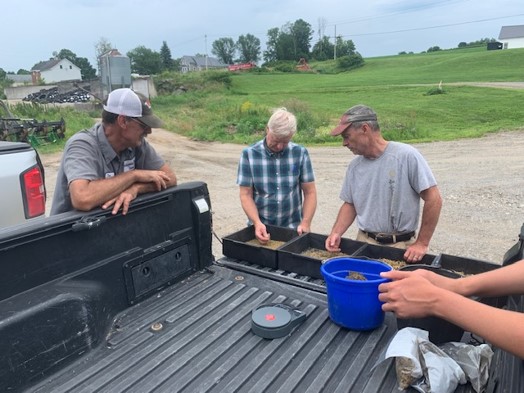A pilot study for the “whole farm” approach to nutrient management
Project summary:
Whole farm nutrient management is a comprehensive approach where all nutrient inputs, outputs, and transfer pathways are considered and optimized for an entire farm’s operation to reduce nutrient losses to waterways and improve farm viability. From 2020 – 2022, a project team at the University of Vermont Extension conducted a pilot study to demonstrate how this approach could be used to reduce phosphorus (P) loading for five farms in critical source areas in the Lake Champlain Basin.
The project team monitored feed and fecal phosphorus levels, herd health, soil health, soil test nutrient levels, milk quality and milk quantity. Through mass nutrient balancing, precision feed strategies, and improved agronomic practices, the pilot’s primary aim was to reduce the amount of imported phosphorus contained in purchased animal feed by increasing the use of home-grown forages.

Key results:
- Reducing farm reliance on imported feed through increased focus on homegrown forages reduced P loading and potential loss to watersheds, and improved farm viability.
- During the project, farms increased their use of farm-grown forage feed from 80% to 92% of the total feed, reducing grain use proportionally.
- These changes in feed management reduced the amount of surplus P on the farm from an average 2.14 tons per year to 0.70 tons P per year.
- Feed storage quality and amount were identified as major drivers of feed degradation, which resulted in the need to purchase feed with higher P inputs to maintain milk production.
- Recommended practices include targeted fertility management on forages, enhanced forage diversity, improved bunk management and feed storage, cow feed management, and maximizing homegrown feeds.
Other takeaways:
- Several factors created challenges during the study, including: overfilling of storage facilities resulting in inadequate feed packing, poor infrastructure conditions leading to the infiltration of oxygen into the stored feed, and the lack of space and ability to separate feed to adequately match the characteristics of the feed with the animals’ nutritional needs.
- Results highlighted the importance of feed storage infrastructure and management to use more homegrown feeds and decrease reliance on imported feed, allowing for reduced phosphorus inputs to a farm.
- The study included the development of a policy recommendations paper and outreach to over 300 stakeholders.